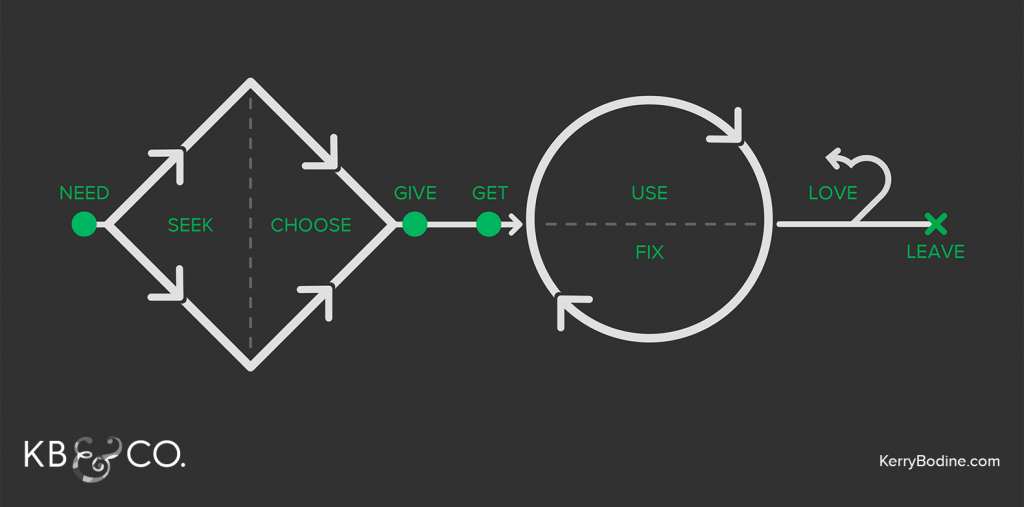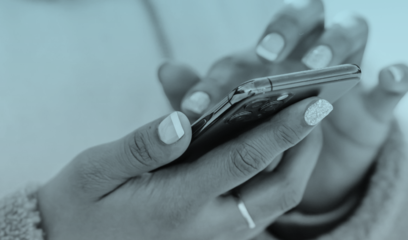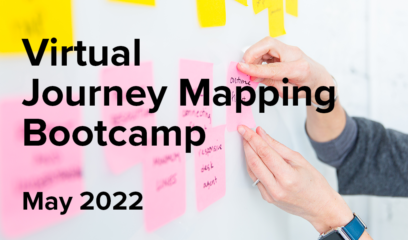Last week I published the first in a series of four posts on how to scale service design, based on my closing remarks at this year’s Service Design Global Conference in Madrid. The focus of that first post was technology. In today’s post, the second in the series, I’ll talk about ubiquity.
“Ubiquity” can mean a lot of things—and at the conference, we heard about service design being leveraged in many different industries and in many different parts of the world. That’s a great indication of both the power of service design and the growing acknowledgement of that power. But the type of ubiquity that I believe is key to scaling service design is different: I believe that we need to leverage service design at every phase of the customer journey.
If you’ve been to my site before, you might have seen my post on the nine stages of the archetypal customer journey: Need, Seek, Choose, Give, Get, Use, Fix, Love, and Leave. Every single interaction your customers (or citizens or patients or whoever you’re design for) have with your organization fits neatly into one of these nine phases.
In the past, service designers have been largely focused on the “Use” phase. That makes sense, as they were focused on ensuring that the core service itself delivered value. (Hence the name “service” design.) But the mindset and methodology of service design can—and I’d argue should—be applied to the entirety of the customer journey.
For the first time this year, I saw presentations and projects that did just that:
- Capital One’s Money Coaching service, a finalist in this year’s Service Design Awards, is a service to help people better understand their financial values and goals—but also acts as a marketing vehicle for the company as prospective customers Need, Seek, and Choose a financial services provider.
- Bridgeable, a Service Design Award winner, worked with TELUS, one of Canada’s largest mobile service providers, to redefine the contract renewals experience, taking us through Love, Give, and Get.
- Uber’s Evi Hui talked about designing the onboarding and education experiences for new drivers going through the Use phase for the first time.
- Uniform Strategisk Design, yet another Service Design Award finalist, designed the Fix experience for rerouting Norwegian State Railways passengers to busses during rail service interruptions.
- And Joe Macleod appropriately delivered the final conference keynote based on his book Ends, which examines how companies need to design coherent endings to product, service, and digital experiences—because like it or not, customers will ultimately Leave.
I was the head of the Service Design Awards jury this year, and in one of our calls to review submissions, one of the jury members—who I’d encouraged to ask challenging questions—questioned whether we should be awarding a “Service Design” award for a project that was essentially a marketing program. The response from the rest of the jury was a resounding “Yes!” And, in fact, we agreed that we’d love to see more marketing that functioned as a valuable service or experience. (Would you rather stare at billboards and get interrupted with pop-up ads? I think not.)
And that’s the major takeaway of the “ubiquity” theme. In order for service design to scale further, we must think beyond just the core of the service we’re designing. We must consider every single aspect of the customer journey—from Need to Leave.
***
Stay tuned! In upcoming posts, I’ll discuss my thoughts on the two other areas where the discipline of service design needs to focus in order to able to scale: coaching and delivery.




